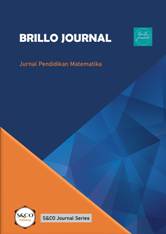Kesulitan Siswa dalam Memecahkan Masalah Barisan dan Deret Aritmatika
DOI:
https://doi.org/10.56773/bj.v1i2.14Keywords:
arithmetic, problem solving, sequences and series, student difficultiesAbstract
The purpose of this research is to analyze students' difficulties in problem-solving in arithmetic sequences and series. The subject of this research is a student at SMA HKBP Lintongnihuta. This research approach is descriptive quantitatively. The types of students' difficulties experienced were analyzed based on Polya's stages of problem-solving. The results of this research are three categories of students based on achievement scores, namely the low category with a percentage of 50%, the medium category with a percentage of 30%, and the high category with a percentage of 20%. There are 4 types of difficulties experienced by students, that is: (1) difficulty in understanding the problem with the number of students experiencing it as much as 28%, (2) students' difficulties in planning problem solving with the number of students experiencing it as much as 11%, (3) students' difficulties in carrying out the plan in problem-solving with the number of students experiencing it as much as 12%, and (4) difficulty in looking back at answers with the number of students experiencing it as much as 8%. The type of difficulty that most students experience is in understanding the problem.
References
Annisa, R., & Kartini, K. (2021). Analisis kesalahan siswa dalam menyelesaikan soal barisan dan deret aritmatika menggunakan tahapan kesalahan Newman. Jurnal Cendekia: Jurnal Pendidikan Matematika, 5(1), 522-532.
Astini, N. K. S. (2020). Pemanfaatan teknologi informasi dalam pembelajaran tingkat sekolah dasar pada masa pandemi covid-19. Lampuhyang, 11(2), 13-25.
Hartati, S. (2021). Analisis Kesulitan Siswa SMA dalam Memahami Materi Barisan dan Deret. SUPERMAT: Jurnal Pendidikan Matematika, 5(2), 85-95.
Lestari, N., Irwan, I., & Afni, K. (2021). Pengaruh Pembelajaran Daring Di Era Pandemi Covid 19 Terhadap Kemampuan Pemecahan Masalah Matematika Siswa Kelas XI Sma Swasta Melati Binjai. Jurnal Serunai Matematika, 13(1), 34-43.
National Council of Teachers of Mathematics. (2000). Principles and Standards for School Mathematics. NCTM
Pirmanto, Y., Anwar, M. F., & Bernard, M. (2020). Analisis kesulitan siswa SMA dalam menyelesaikan soal pemecahan masalah pada materi barisan dan deret dengan langkah-langkah menurut Polya. JPMI (Jurnal Pembelajaran Matematika Inovatif), 3(4), 371-384.
Polya, G. (2004). How to solve it: A new aspect of mathematical method. Princeton university press.
Rambe, A. Y. F., & Afri, L. D. (2020). Analisis kemampuan pemecahan masalah matematis siswa dalam menyelesaikan soal materi barisan dan deret. AXIOM: Jurnal Pendidikan Dan Matematika, 9(2), 175-187.
Saifuddin, I., Zubaidi, Z., Partono, P., & Nurdhuka, M. (2018). Analisis kesulitan siswa pokok bahasan barisan dan deret kelas X IPS SMA 1 Blora. Jurnal Teladan: Jurnal Ilmu Pendidikan Dan Pembelajaran, 3(2), 99-109.
Saragih, E. M., & Handayani, S. (2020). Pengaruh model pembelajaran mastery learning terhadap kemampuan pemecahan masalah matematika siswa pada materi matriks. Jurnal mathematic paedagogic, 4(2), 163-174.
Saragih, M. J. (2019). Perlunya Belajar Mata Kuliah Aljabar Abstrak Bagi Mahasiswa Calon Guru Matematika. Jurnal Cendekia: Jurnal Pendidikan Matematika, 3(2), 249-265.
Sitorus, A. A. (2021). Disinkronisasi Kebijakan Pemerintah Indonesia dalam Penanganan COVID-19. Jurnal Renaissance, 6(1), 721-732.
Wulandari, M., & Setiawan, W. (2021). Analisis kesulitan dalam menyelesaikan soal materi barisan pada siswa SMA. JPMI (Jurnal Pembelajaran Matematika Inovatif), 4(3), 571-578.
Zellatifanny, C. M., & Mudjiyanto, B. (2018). Tipe penelitian deskripsi dalam ilmu komunikasi. Diakom: Jurnal Media Dan Komunikasi, 1(2), 83-90.
Downloads
Published
How to Cite
Issue
Section
License
Copyright (c) 2022 Brillo Journal

This work is licensed under a Creative Commons Attribution 4.0 International License.
The authors agree that this article remains permanently open access under the terms of the Creative Commons Attribution 4.0 International License





